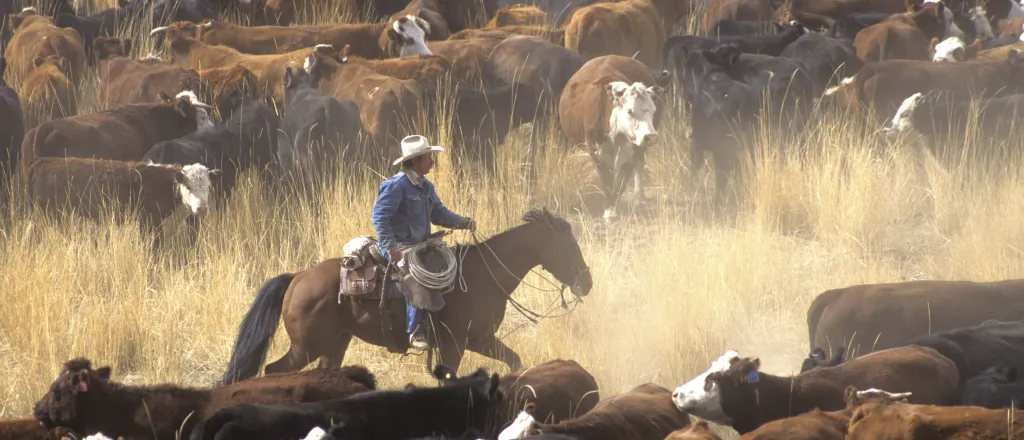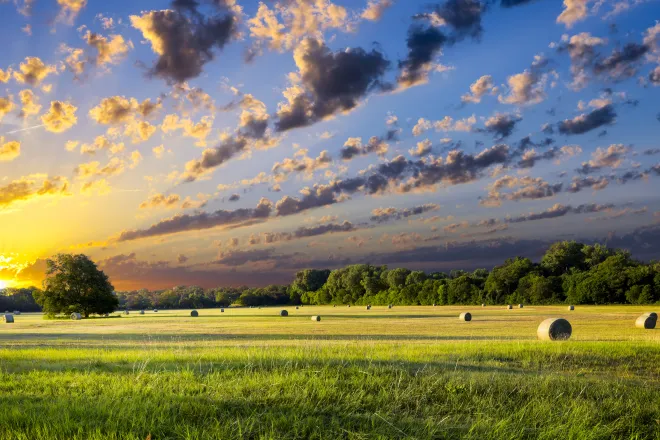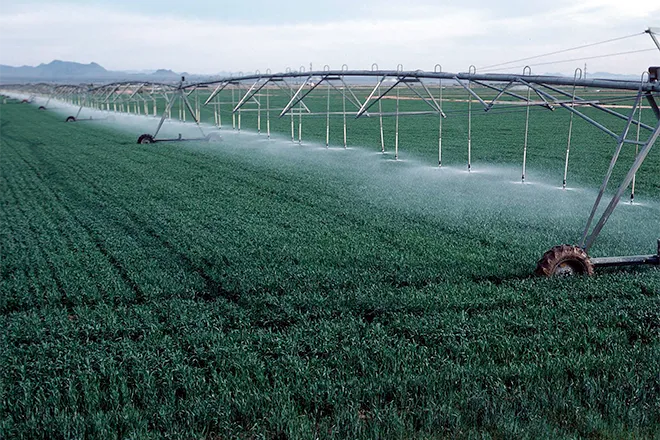
Transcript
[Music]
Welcome to the Pasture to Profit podcast.
I'm one of your hosts, Scott Stennett, 4-H and Livestock Extension Specialist at Colorado State University.
And I'm joined by Travis Taylor, who is the Golden Plains Area Livestock Specialist here for Colorado State University.
So, Travis, it's that time of year we're starting to see greener pastures.
We're getting things off of the old wintering grounds.
We've stopped our supplemental feedings, we hope, of hay and other things.
But we need to think about what those pastures are going to provide nutritionally for our cattle herd.
So, when we turn these cows out, what do we need to think about for the nutrition of our cow herd?
Well, Scott, you know, summer turnout is one of those fun things for ranchers because we're tired of feeding cows.
We want to see them out making a living on their own.
But we just need to remember that pastures will supply most of the nutrients needed if their pastures are in good shape.
But that's not always the case here in the Golden Plains area.
When we do turn out in the spring.
So, you know, these spring calving cows will be at the time of turnout just about meeting their peak lactation, which happens 60 to 70 days post calving.
So, as we've processed these calves and we've turned them out, those cows are going to be milking at their highest level.
And we're hoping that's on green grass.
But we're also going to be trying to rebreed her with her calf at side.
So, I think there's some nutritional things that we need to think about.
Number one is those cows need to be in a positive energy balance.
If they're decreasing in body condition due to being very heavy milking cows or cows that maybe we don't have as green a grass or it's been a delayed cool spring where we haven't had some green grass growth.
They may be short in terms of what they're needing.
Just kind of as a rule of thumb, we feed cows about 50 percent of what their nutritional needs are in terms of calcium and phosphorus.
So, we look at those two minerals and try to meet them with supplementation about half.
When you're looking at this, you may also have a soil or something that's deficient in a certain mineral.
And it's probably important to provide 100 percent of the cow's balance for some trace minerals such as cobalt, copper, iron, magnesium, and zinc.
And, you know, as a general rule, if you're adding those in either an injectable, which would make sure that we would get those into the cow, or if we're mixing those and offering them as free choice, something like dicalcium phosphate, we need to make sure that we're maybe mixing that in with some salt to make those really harsh minerals a little more palatable and allow those cows to uptake it because this time of year, they will be hitting that salt lick.
And if we can mix that in with some granulated salt, they're sure to get a little more of that in there.
If it has been one of those dry springs where maybe we're turning out on some older grass, we might need to think about supplementing with some vitamin A in some kind of mineral mix just to make sure that those cows, after decreasing vitamin A out of their liver all winter, may need a little extra supplementation to help ensure that we're meeting all their nutritional needs, particularly at an important time when we're trying to rebreed these cows to get them to calve on time a year from now.
Yeah, because, but the really sad thing is a lot of this is a moving target.
We've got cows, especially those that are lactating nursing calves, their nutritional needs are going to change as we're going through that change in lactation, change in lactational needs for those calves.
Our pastures are going to change.
They're going to, maybe we'll get lucky and we get the nice green up that lasts all the way through June, but we may go through kind of a roller coaster of green up and brown to green up to brown all season.
And I think the big thing, anecdotally, a lot of producers use is just consumption by cattle.
You may go to one pasture and it's really greened up because, you know, we can get these spotty precipitations out here and they're going through a lot of salt.
And then you get to the next pasture and they've hardly touched the salt.
So I think the big thing I would encourage producers on our end is, you know, whatever you're trying to supplement, kind of watch your cattle and watch their consumption.
They'll tell you a lot about what they need.
Absolutely, Scott.
I think you hit it on the head when you talk about no two pastures are going to be the same.
There's difference.
We have pastures that are very flat and water holds.
And then we have those pastures that have some hills and draws and it's green in the draws and it's dry up on the hills.
And no two pastures are going to be the same.
And they're not going to be the same each year because we've had a different growing season.
So we can't always do what we've done.
But I agree with you.
If we're watching what those cattle are consuming, how much mineral intake they are getting, then I think we have a better idea of maybe what we need to meet their nutritional requirements.
And, you know, one of those things, we have a lot more injectable minerals as you're processing these cows.
If you're running them through the chute and putting a fly tag in, you may want to consider some injectable mineral supplementation for these cows as they go out, particularly if you feel like it's going to be one of those years where it's going to be a little tough to get cows re-bred.
Right.
And we need to remember when we're if we're going to give injectables, we need to follow our good BQA guidelines and put it in that injection triangle up in the neck.
But when we get to these pastures, you know, here on the high plains in eastern Colorado, we tend to we don't ever tend to plan for the nice lush times.
We always are prepared for drought is what we should be.
So when we do have pastures that come up short, when the grass stops greening up, it's not going to provide everything quite that we need.
What can we see is going to be the response to the cattle when they don't have everything they need?
What's what's going to tell us that they're inadequate or short on their nutritional needs?
Well, we're going to see decreased milk, OK?
And like we said, we're hitting that peak lactation at two months post calving, 60 days.
The problem that we have is the higher we can make our peak lactation, the longer it takes to drop off and the more that milk that cow's going to produce over a hundred and seventy five to two hundred and five day lactation period.
So we want to make that peak as high as we can.
If we're seeing these short pastures and we see decreased milk production, that's going to decrease it more over the time span.
So we want to make sure we're doing that.
Also, if we have first calf heifers that are still growing, trying to milk, trying to rebreed, we're going to probably need to provide some supplementation.
And if we're going to continue to supplement with a forage on some of these pastures, I recommend a very high quality legume, alfalfa type hay and kind of remember the rule of five and ten.
Five pounds of a good quality forage will replace about a third of what that cow's nutritional needs going to be on pasture.
Ten pounds will replace two thirds.
And if it's a high quality forage, we don't need to be feeding as much of it.
And those cows will tend to clean it up.
If it's a dryer type forage, say sorghum hay or something, feeding out there, they're probably going to leave that and spend their time running off a lot of weight looking for green grass.
So if we are going to supplement it, it'll be worth trying to find a good quality legume or alfalfa forage to supplement with.
If you have to supplement, particularly maybe those first calf heifers, a little while longer, if the grass hasn't totally greened up in our drought area of the high plains.
Well, yeah, I'm providing those supplementations, you know, may depend upon the type of pasture that we're on as well.
So we've got various things that are out there from our native pastures to some improved pastures.
So but why does that matter?
You know, we'd love to say that everything is perfect nutritionally, but in pastures, some plants come on early, some plants come on late, some plants provide more and others provide less.
So why does pasture type and makeup matter?
Well, if we talk about legume pastures, they tend to green up a little earlier than, say, maybe our native warm season grasses that we see.
We're definitely going to maybe supplement them a little differently because cows tend to bloat on legume pasture.
So if we have a lot of legumes coming early and they're running through and selectively grazing off, say some alfalfa or somebody's put some trefoil or something in that pasture is an improved pasture and we're selecting that off.
We may need to supplement with something a little dry.
Maybe that's where your sedan haze come back in and we can supplement that.
Also, we don't see as much of it here, but if we have if we're grazing some of those cover crops, we want to graze those off so that we can go back in and plant something and get some benefit from some cover that we put on the ground, particularly with some of our new star programs in our natural resources side that producers are getting paid for.
So if we're grazing those pastures off with cows, we can definitely boost milk production at this point in time and get some vital utilization out of our maybe oats or rye that we've used for a cover crop to try to keep those cows and get the most benefit out of it.
But those are going to be very green.
Those are going to be pastures where we're probably definitely going to want to supplement with some magnesium before we go out there to help us with instances of grass tetany where we've really caused an imbalance.
I think the biggest issue that we have probably as we go to some of these green lush pastures is we would have I'm milking cows that are depleting their system.
And we need to make sure that the calcium and magnesium balance in those cows is up to par.
So we don't run into problems like grass tetany.
But if we go from a totally dry 100 percent fed forage to turn out on lush green pasture, we can see some problems with those kind of issues too.
So like you said, cover crops can be great, but they provide their own issues as well, Scott.
Well, yeah.
And producers also need to think about that changeover within the rumen.
If you've been on a very dry, whether you were being supplemented with hay in a dry lot situation on a winter pasture, or they've been on corn stalks, that rumen and all those microorganisms in there need to change over and rebuild their populations to be ready for green grass and a native pasture.
So we need to think about that as well.
Well, and absolutely, if we're talking about rebreeding them, one of those mistakes that people tend to make is we try to put these heifers in a lot and we AI them.
And then we turn them out on a dry forage when they've been getting a totally balanced ration in a lot for 23, 24 days.
And it takes a while for that to turn over.
So like we said, we want to make sure as we're breeding, they're in a positive energy balance instead of totally changing their diet.
And even for a short period of time, putting them into a negative balance.
Right.
And like I said before, it's a roller coaster and a moving target.
Every day, every week is going to be a little bit different with these cows, with these pastures, with the weather and what we're going to be provided through this summertime seasonal grazing.
The last thing, Scott, is if you are turning out, make sure you know what's there.
If we have some toxic weed issues in our area, or if you've gotten a lot of rain and it's run down the draws, take a look and see what's there.
Because the last thing you want to do is turn out on some toxic type plant and lose some cows on young cuckleburs.
You know, we saw some cows last year because of some rain.
There's some weeds that we hadn't seen in four or five years that were back in the area.
So make sure that you know what's out there.
Drive that pasture.
Take a look at it.
And make sure you don't have some odd weed that's out there that's going to cause you some problems as we go forward.
Absolutely.
Some good range management, some plant ID.
Don't just turn them out and expect what was there last year to be there this year, because it can definitely change from year to year.
All right.
So great thoughts today, Travis.
Really appreciate that.
Hopefully, producers will take advantage of some of these ideas and have some successful grazing this summer.
But anything else you want to wrap up with before we go for today?
I think we've kind of hit the basics, Scott.
And remember, just like you said, pastures change year to year.
So make sure that you're doing your due diligence to pay attention to what's there and pay attention to what your cows are eating in terms of supplementation.
All right.
Well, if you have any questions on our discussion for today or you have any ideas for topics to discuss in the future, feel free to contact us here at Pasture to Profit.
I'm Scott and I can be reached here at the Kitt-Carson County Extension Office at 719-346-5571.
And Travis?
Yeah, I can be reached at the Yuma County Extension Office at 970-332-4151.
And Scott, make sure that you go to pasture to profit.podbean.com and check out some of our earlier Pasture to Profit episodes.
Or you can go to our Golden Plains Area website, go through the Banner to Programs, scroll down to livestock, and we're at the top of the livestock page with those episodes.
So tune in or call us if you have a suggestion on something you'd like to see on our next Pasture to Profit podcast.
So again, thanks for listening and joining us here on the Pasture to Profit podcast.
We hope that you'll tune in next time.
[Music]








